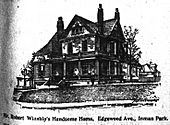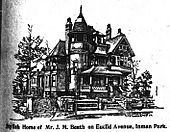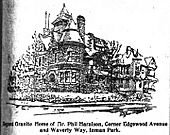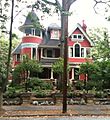Inman Park facts for kids
Quick facts for kids |
|
|
Inman Park Historic District
|
|
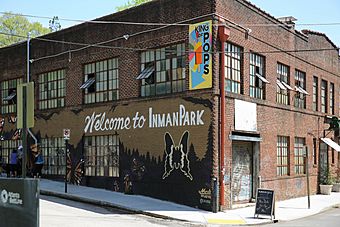
Welcome Sign in Inman Park
|
|
| Location | Roughly bounded by Freedom Parkway, DeKalb and Lake Aves. (original) and Roughly bounded by Lake, Hurt, and DeKalb Aves., and Krog St. (increase), Atlanta, Georgia |
|---|---|
| Built | 1889 |
| Architect | Multiple |
| Architectural style | Queen Anne, Shingle Style (original); Queen Anne, Stick/Eastlake, Colonial Revival, Shotgun, Bungalow, Arts & Crafts, Romanesque Revival, Prairie Style, Arts & Crafts Revival, et al. (increase) |
| NRHP reference No. | 73000621 and 01000973 |
| Added to NRHP | July 23, 1973 (original) September 16, 2001 (increase) |
Inman Park is a historic neighborhood in Atlanta, Georgia. It is located on the east side of the city. It was Atlanta's very first planned neighborhood, designed to be a beautiful place to live just outside the busy city center. The neighborhood is named after Samuel M. Inman.
Contents
History of Inman Park
Today, the Inman Park neighborhood includes several older areas. These include the original Inman Park, Moreland Park, and parts of Copenhill Park. Some former industrial areas on the west side have also been turned into new mixed-use areas.
This area was once a battlefield during the Battle of Atlanta in 1864.
Atlanta's First Streetcar Suburb
Inman Park was planned in the late 1880s by Joel Hurt. He was a civil engineer and real estate developer. Hurt wanted to create a peaceful, green neighborhood connected to the city. He did this using Atlanta's first electric streetcar lines along Edgewood Avenue.
Hurt's company bought over 130 acres of land east of the city. He named the new neighborhood after his friend and business partner, Samuel M. Inman. Joseph Forsyth Johnson was the landscape designer for Inman Park. He designed curved streets and lots of open green spaces.
In 1896, the Atlanta Constitution newspaper described Inman Park as a wonderful place. It said the neighborhood was "high up above the city" with "purest breezes and brightest sunshine." It was meant to be a place of "pretty homes, green lawns, and desirable inhabitants." The article also mentioned that "everybody is friendly and neighborly." It also said Inman Park was easy to reach, with "three car lines and frequent schedules."
Like many new developments at that time, Inman Park was planned for specific groups of people. Moreland Park, another part of today's Inman Park, grew more slowly. It was built up in smaller sections over time.
Changes Over Time
When cars became popular, people could live further from downtown. Wealthier Atlantans began moving to newer suburbs like Morningside and Buckhead. Inman Park became less popular. Its grand Victorian houses started to seem old-fashioned. Many of these large homes were divided into smaller apartments.
During the 1950s and 1960s, Inman Park faced tough times. Many middle and upper-class families moved away from the city. The neighborhood became less wealthy. Many people lived in rented bungalows or apartments in the old, large houses.
Bringing Inman Park Back to Life
Inman Park was the first neighborhood in Atlanta to be "gentrified." This means people started moving back in and improving the area. Robert Griggs and Robert Aiken bought the historic Beath-Dickey House. It was a run-down rental property at the time. They fixed it up and made it a single-family home again.
Others followed their lead, restoring more homes. They formed the Inman Park Restoration neighborhood association. They also started a newsletter, a garden club to care for public spaces, and a pre-school. To show off their progress, they began a "Tour of Homes." This small event grew into the very popular Inman Park Festival, held every spring.
Fighting the Freeway
Around the same time, there was a big fight against the I-485 freeway. This freeway was planned to cut right through the neighborhood. Many properties in Inman Park were torn down to prepare for its construction. However, the freeway was never built through the neighborhood due to strong community opposition.
Inman Park Today
After many years of restoration, Inman Park is now a very popular neighborhood. It has a mix of rented and owned homes and condos. The houses range from small "shotgun" homes to grand Victorian mansions. There are also many bungalows built in the early 1900s.
The people living in Inman Park today are diverse. The neighborhood association welcomes both renters and homeowners. The Inman Park Festival is a huge event each spring. It is the largest all-volunteer festival in Georgia. The Tour of Homes is a main part of the festival. It shows off the many different types of homes in the area.
Old industrial areas on the west side of the neighborhood have been redeveloped. The former General Pipe and Foundry site is now North Highland Steel. The old Mead paper plant site is now Inman Park Village. The Atlanta Stove Works building became a film and media production center. In 2015, it was turned into offices and restaurants. This area will now be part of the Krog Street Market.
Geography of Inman Park
Inman Park is surrounded by other Atlanta neighborhoods:
- To the west is the Old Fourth Ward, across the BeltLine Eastside Trail.
- To the north is Poncey-Highland, across Freedom Parkway.
- To the east is Candler Park, across Moreland Avenue.
- To the south are Cabbagetown and Reynoldstown, across DeKalb Avenue.
The Little Five Points district is where Inman Park and Candler Park meet.
Architecture in Inman Park
Inman Park has many beautiful old homes from the late 1800s and early 1900s. You can see different styles like Queen Anne, Italianate, and Romanesque mansions. There are also smaller bungalows, shotgun houses, and foursquares.
Inman Park was Atlanta's first "garden suburb." This means its streets, parks, and public spaces were carefully planned. It inspired other Atlanta garden suburbs, like Druid Hills.
There are two historic districts within Inman Park: the Inman Park historic district and the Inman Park-Moreland Historic District.
Some famous houses in the neighborhood include:
- Beath-Dickey House
- Callan Castle (Candler mansion)
- Kriegshaber House (Wrecking Ball Brewpub)
Other Cool Places to See
- The Krog Street Tunnel goes under the CSX Railroad. It connects Inman Park to Cabbagetown and is famous for its amazing street art.
- Krog Street Market is a popular place with many different food vendors and restaurants.
- Edgewood Avenue has become a well-known street for restaurants since 2013.
- Highland Avenue connects Inman Park to the Poncey Highland and Virginia Highland neighborhoods. This street also has many local restaurants and shops.
Parks in Inman Park
Inman Park has several parks. Springvale Park was a special project of Joel Hurt. It was designed by the Olmsted Brothers. Part of Freedom Park is also in the neighborhood. The BeltLine trail runs along its border. Other smaller parks include Delta Park, Inman Park, the park in Inman Park Village, and the Bass Recreation Center.
Local Government
Inman Park is part of Neighborhood Planning Unit N. Neighbors can join the Inman Park Neighborhood Association (IPNA) to help make decisions about their community.
Schools in Inman Park
Students in Inman Park attend schools run by Atlanta Public Schools. The zoned schools for the area are:
- Inman Middle School
- Henry W. Grady High School
Getting Around
MARTA provides bus and train service in Inman Park. The Inman Park / Reynoldstown MARTA station is located at the south end of the neighborhood, making it easy to travel by train.



